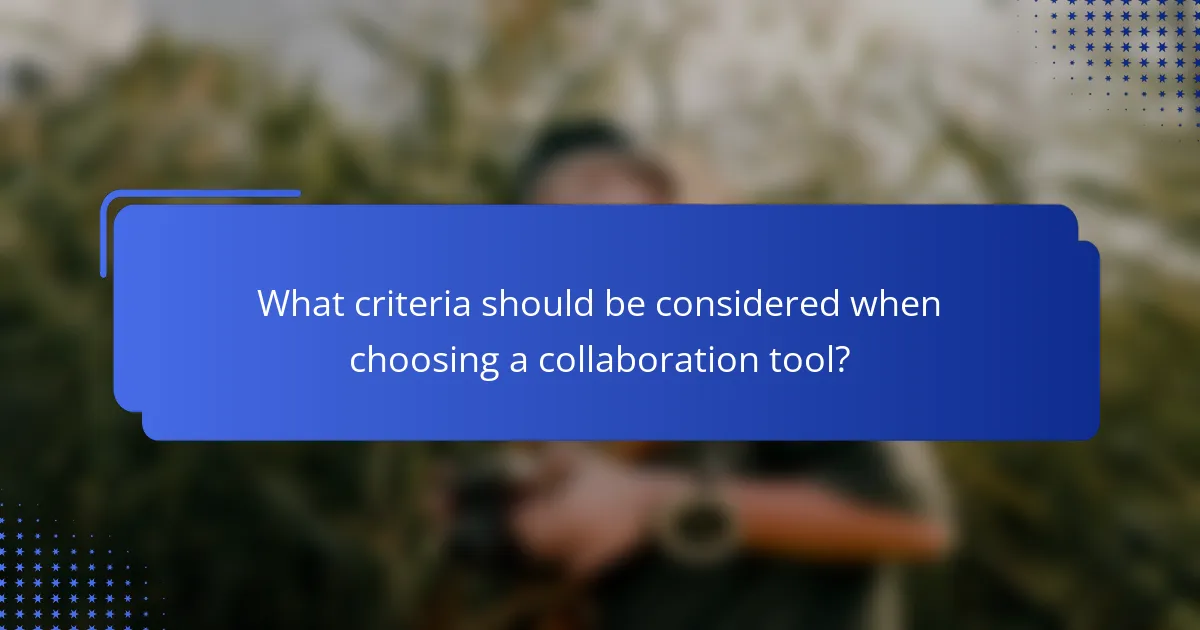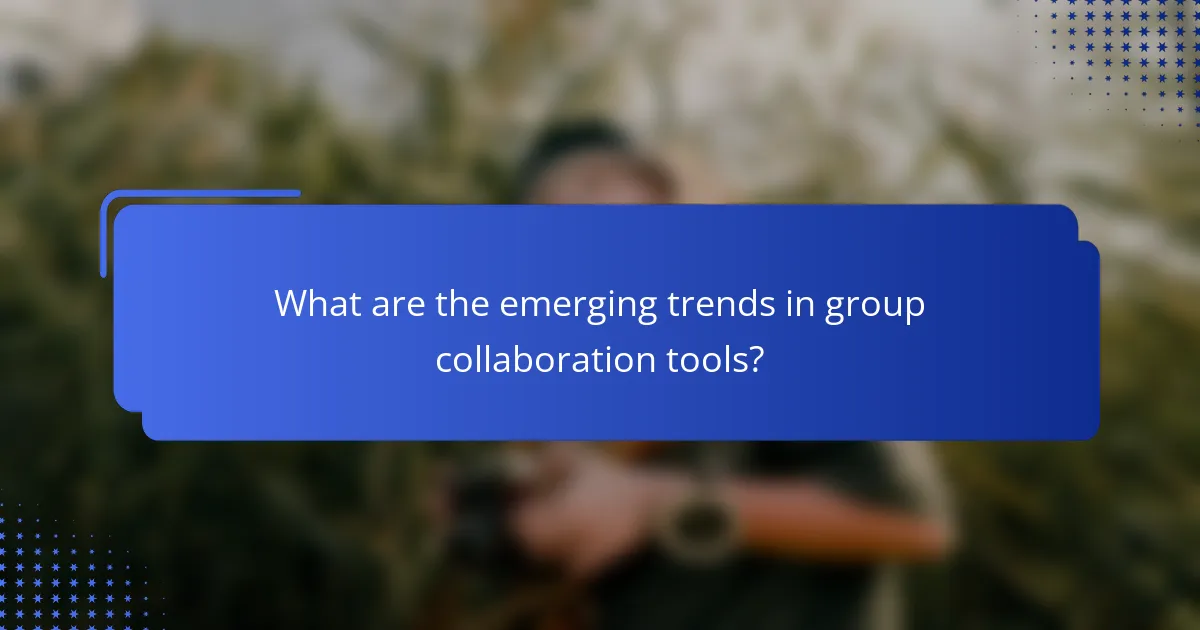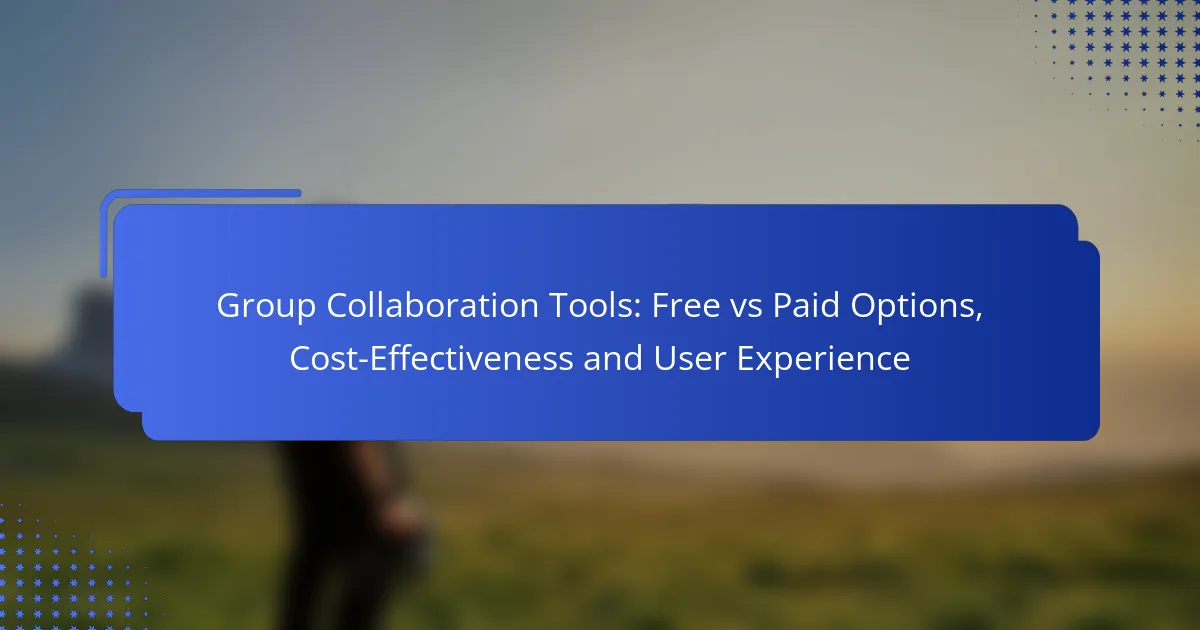In today’s collaborative work environment, choosing the right group collaboration tools is crucial for enhancing team productivity and communication. With a variety of free and paid options available, teams must assess their specific needs to determine the most effective solution. While free tools can suffice for basic tasks, paid options often deliver advanced features that can significantly improve user experience and project management capabilities.

What are the best group collaboration tools in the UK?
The best group collaboration tools in the UK include a mix of free and paid options that cater to various team needs. These tools enhance communication, project management, and overall productivity, making it easier for teams to work together effectively.
Slack
Slack is a widely used messaging platform that facilitates real-time communication among team members. It offers channels for specific topics, direct messaging, and integrations with various apps, making it versatile for different workflows.
While Slack has a free version, its paid plans provide additional features like unlimited message history and enhanced security options. Teams should consider their size and communication needs when choosing between the free and premium versions.
Trello
Trello is a project management tool that uses boards, lists, and cards to organize tasks visually. It is particularly effective for teams that prefer a Kanban-style approach to tracking progress on projects.
The free version of Trello is suitable for small teams, but larger organizations may benefit from the paid plans, which offer advanced features like automation and integrations. Users should evaluate their project complexity to determine the right plan.
Microsoft Teams
Microsoft Teams combines chat, video conferencing, and file sharing in one platform, making it a comprehensive collaboration tool. It integrates seamlessly with other Microsoft 365 applications, which is beneficial for organizations already using that ecosystem.
While Microsoft Teams is free for basic use, organizations may find value in the paid plans that include additional storage and advanced security features. Teams should assess their existing software to maximize integration benefits.
Asana
Asana is a project management tool designed to help teams plan, track, and manage their work. It offers features such as task assignments, deadlines, and project timelines, making it easier to keep everyone aligned.
The free version of Asana is effective for small teams, but larger teams may require the paid plans for features like timeline views and advanced reporting. Teams should consider their project management needs when selecting a plan.
Zoom
Zoom is a video conferencing tool that has gained popularity for its ease of use and reliability. It allows for virtual meetings, webinars, and screen sharing, making it ideal for remote collaboration.
While Zoom offers a free tier with time limits on meetings, the paid plans provide extended meeting durations and additional features like cloud recording. Teams should evaluate their meeting frequency and size to choose the appropriate plan.

How do free group collaboration tools compare to paid options?
Free group collaboration tools often provide essential features for basic teamwork, while paid options typically offer advanced functionalities and enhanced support. The choice between free and paid tools depends on the specific needs of the team, including project complexity and collaboration requirements.
Features of free tools
Free collaboration tools usually include fundamental features such as messaging, file sharing, and basic project management capabilities. Examples include platforms like Slack’s free version or Trello’s basic plan, which allow teams to communicate and organize tasks effectively without any cost.
However, these free options often come with limitations, such as reduced storage capacity, fewer integrations, and restricted access to advanced features. Teams may find themselves constrained by these limitations as their projects grow in complexity.
Benefits of paid tools
Paid collaboration tools offer a range of benefits, including enhanced features like advanced analytics, increased storage, and priority customer support. For instance, tools like Microsoft Teams or Asana provide robust functionalities that can significantly improve productivity and streamline workflows.
Investing in paid tools can lead to better team collaboration and efficiency, especially for larger teams or projects requiring extensive coordination. The cost, typically ranging from a few dollars to over a hundred per user per month, can be justified by the increased productivity and reduced friction in communication.

What is the cost-effectiveness of group collaboration tools?
The cost-effectiveness of group collaboration tools depends on the specific needs of a team and the features offered by each tool. Free options can be suitable for small teams or basic projects, while paid tools often provide advanced functionalities that justify their costs.
Cost analysis of free tools
Free collaboration tools typically offer essential features like messaging, file sharing, and basic project management. These tools can be effective for small teams or startups with limited budgets, but they may lack advanced functionalities such as integrations, security features, or customer support.
Common free tools include Slack’s free version, Trello, and Google Workspace’s basic tier. While these options can be sufficient for light use, teams should consider potential limitations, such as storage caps or user limits, which may hinder productivity as the team grows.
Pricing models for paid tools
Paid collaboration tools usually operate on subscription models, charging monthly or annually per user. Prices can vary widely, ranging from low single-digit USD amounts to higher tiers for enterprise solutions that offer extensive features and support.
When evaluating paid options, consider the features that align with your team’s needs, such as enhanced security, advanced analytics, or integrations with other software. Some popular paid tools include Microsoft Teams, Asana, and Monday.com, which often provide free trials to help teams assess their value before committing.

How does user experience differ between free and paid tools?
User experience between free and paid collaboration tools often varies significantly. Free tools may offer basic functionalities with limited features, while paid options typically provide enhanced usability, advanced features, and better support, leading to a more efficient workflow.
User interface of free tools
The user interface of free collaboration tools is often straightforward but can lack advanced design elements. These tools usually prioritize essential functionalities, which may result in a cluttered layout or limited customization options. Users may find basic navigation intuitive, but the absence of advanced features can hinder productivity.
For example, platforms like Trello’s free version allow task management but may restrict integrations and automation, making it less efficient for larger teams. Users should be prepared for potential limitations in features such as file storage and user support.
User interface of paid tools
Paid collaboration tools generally offer a more polished and user-friendly interface, designed to enhance productivity. These tools often include customizable dashboards, advanced analytics, and seamless integration with other software, providing a more cohesive experience. The design is typically more intuitive, reducing the learning curve for new users.
For instance, tools like Asana and Slack provide extensive features like project tracking and real-time messaging, which are often more sophisticated in their paid versions. Investing in these tools can lead to improved team collaboration and efficiency, especially for larger organizations or projects with complex requirements.

What criteria should be considered when choosing a collaboration tool?
When selecting a collaboration tool, consider factors such as integration capabilities, scalability options, user experience, and cost. These criteria help ensure that the tool meets your team’s specific needs and enhances productivity.
Integration capabilities
Integration capabilities refer to how well a collaboration tool connects with other software and services your team uses. A tool that seamlessly integrates with project management, communication, and file storage applications can streamline workflows and reduce the need for manual data transfers.
Look for tools that offer APIs or pre-built integrations with popular platforms like Slack, Google Workspace, or Microsoft Teams. This can enhance functionality and improve user experience by allowing teams to work within a familiar environment.
Scalability options
Scalability options determine how well a collaboration tool can adapt to your team’s growth. A good tool should accommodate an increasing number of users and projects without sacrificing performance or usability.
Consider whether the tool offers tiered pricing plans that allow you to upgrade as your team expands. Some tools may provide features that are only available at higher price points, so assess what you might need in the future to avoid switching costs later.

What are the emerging trends in group collaboration tools?
Emerging trends in group collaboration tools focus on enhancing user experience and adapting to modern work environments. Key developments include the integration of AI, adaptations for remote work, and improved security features to protect sensitive information.
AI integration
AI integration in group collaboration tools streamlines workflows and enhances productivity. Features like smart scheduling, automated task assignments, and real-time language translation are becoming standard, allowing teams to communicate and collaborate more effectively.
For example, tools like Microsoft Teams and Slack are incorporating AI-driven chatbots that can assist users in finding information quickly or managing tasks. This not only saves time but also reduces the cognitive load on team members.
Remote work adaptations
As remote work becomes more prevalent, collaboration tools are evolving to support distributed teams. Features such as virtual whiteboards, video conferencing enhancements, and asynchronous communication options are essential for maintaining productivity across different time zones.
Tools like Zoom and Miro offer functionalities that cater specifically to remote collaboration, enabling teams to brainstorm and share ideas in real-time, regardless of their physical locations. This adaptability is crucial for businesses aiming to attract talent globally.
Enhanced security features
Enhanced security features are increasingly vital in group collaboration tools, especially with the rise of remote work. Tools are now implementing end-to-end encryption, multi-factor authentication, and compliance with regulations like GDPR to protect user data.
For instance, platforms such as Trello and Asana provide robust security settings that allow organizations to control access and manage permissions effectively. Prioritizing security not only safeguards sensitive information but also builds trust among team members and clients.
